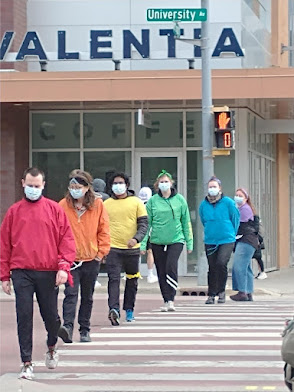Performance Art
Now in my first year of graduate school at UW Madison, I have taken a Performance Art class with Laurie Beth Clark and Michael Peterson. This class mixed theory with practice and I created four performances that I will share below. Each performance had a theme and criteria so that we could explore different elements of the craft. The four performances were Durational, Temporal, Spatial, and Social. My biggest take-away from this class is the introduction to the medium of time to my work and understanding functionality and performativity to be nearly synonymous.
Durational Performance. The goal of this piece was to consider intentionally passing time by doing something for an entire day; durational performance as enduring time. For this piece, I aimed to use performance art as a tool to help overcome daily anxiety and indecision. I created a spinning wheel made from cardboard which outlined possible answers to decision-making questions throughout the day. The wheel could spin on “yes”, “no”, or “spin again”, and I quickly leaned the wheel was accidently weighted to fall on “no” most of the time. This performance quickly became about a force outside of my control limiting my ability to make decisions for myself, rather than a tool to help me decide what to make for dinner. By the end of the day, I was tailoring my questions to get my own permission to complete the tasks I wanted to.
Overall, this project taught me to think differently about my relationship to decision making and made me reflect on my own privilege. I reflected on the fact that I usually have the ability and agency to make all of my own decisions. I was feeling gratitude for my able body and my free will. What started as a simple exercise in alleviating executive dysfunction and decision anxiety became a reflection on shame, control, and my own privilege.
Temporal Performance. The criteria for this piece included the notion that something unfolded over time, that an audience member could watch for a short duration and witness something changing. Reflecting upon my durational piece, I stayed with the theme of anxiety and indecision and explored the idea of projecting those sensations onto an audience. In this case, we met on Zoom and I instructed my classmates to re-organize their grid of classmates by given criteria. I stood in my kitchen with a background of bright lights and a spinning ceiling fan and simultaneously played two different fast-tempo jazz drum solos (by Gene Krupa) in order to mimic overstimulation and sensory overload. I spoke quickly and as the performance went on I became more and more frazzled, as did some audience members. Although I had intended on making my audience feel anxious and overwhelmed, to mimic how I myself feel at times, only a few felt that way.
Spatial Performance. I have often thought of the function of craft as meditative and healing. Sometimes I find myself creating work just so I can feel the tools in my hand. I pick up a gouge and start carving on a piece of scrap wood because my hands need something to do. While normally the craft process would lead to a final object, this piece explored the idea that the process is the product in itself. The medium of performance allowed me to show another angle to the role of craft processes in my work.
I set up a woodworking bench in a large empty gallery and planed the edge of a board of mahogany for three hours. This action was very slow and was synced with my breath; breathe in, step forward, breathe out, pull a shaving, place it on the floor, repeat. My aim was for the action to be meditative and self-soothing. It was also endurance, as seen by the blister on my hand and the red streak in my handplane.
View the full 1-1/2 hour long video here.
Social Performance. This performance was a collaborative piece between myself, Dan Van Note, Derick Wycherly, Kagen Dunn, Praveen Maripelli, and Victoria Hoff. We were considering the role of social practice as care for the community, and were interested in working with the community of students on campus near the end of the semester. After a long year of covid, civil unrest, and academic work, we wanted to spread joy to the students on campus.
We dressed in a rainbow of colors (I was blue) and all crossed a large crosswalk while performing a set of actions set forth by each of the performers. The first round was Dan (red) and we walked slowly to try to take up the entire time of the crosswalk signal. The second round was Derick (orange), and we flapped like birds across the crosswalk then took roost when we reached the sidewalk. The third round was Praveen (yellow), and we walked in a single-file line and alternated facing back-to-back. The fourth round was Kagen (green) and we skipped across, trying to make our jump up higher than our jump out was far. For my round, we used the Paired Muscle Relaxation therapy technique, tensing and stopping as we breathed in, and relaxing and walking while breathing out. The final round was Victoria (purple), and we stood in a line on the crosswalk and stared and waved at cars at the red light. The highlight of the performance was when an audience member wearing indigo crossed the walk with us and completed our rainbow.







